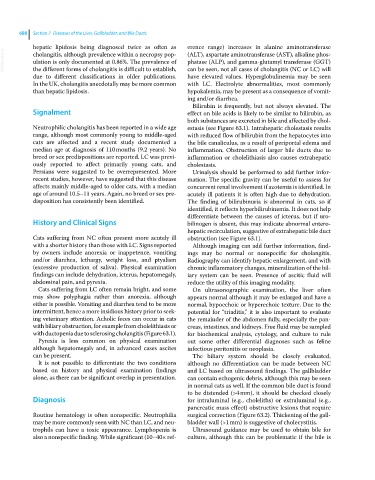Page 720 - Clinical Small Animal Internal Medicine
P. 720
688 Section 7 Diseases of the Liver, Gallbladder, and Bile Ducts
hepatic lipidosis being diagnosed twice as often as erence range) increases in alanine aminotransferase
VetBooks.ir cholangitis, although prevalence within a necropsy pop- (ALT), aspartate aminotransferase (AST), alkaline phos-
phatase (ALP), and gamma‐glutamyl transferase (GGT)
ulation is only documented at 0.86%. The prevalence of
the different forms of cholangitis is difficult to establish,
have elevated values. Hyperglobulinemia may be seen
due to different classifications in older publications. can be seen, not all cases of cholangitis (NC or LC) will
In the UK, cholangitis anecdotally may be more common with LC. Electrolyte abnormalities, most commonly
than hepatic lipidosis. hypokalemia, may be present as a consequence of vomit-
ing and/or diarrhea.
Bilirubin is frequently, but not always elevated. The
Signalment effect on bile acids is likely to be similar to bilirubin, as
both substances are excreted in bile and affected by chol-
Neutrophilic cholangitis has been reported in a wide age estasis (see Figure 63.1). Intrahepatic cholestasis results
range, although most commonly young to middle‐aged with reduced flow of bilirubin from the hepatocytes into
cats are affected and a recent study documented a the bile canaliculus, as a result of periportal edema and
median age at diagnosis of 110 months (9.2 years). No inflammation. Obstruction of larger bile ducts due to
breed or sex predispositions are reported. LC was previ- inflammation or cholelithiasis also causes extrahepatic
ously reported to affect primarily young cats, and cholestasis.
Persians were suggested to be overrepresented. More Urinalysis should be performed to add further infor-
recent studies, however, have suggested that this disease mation. The specific gravity can be useful to assess for
affects mainly middle‐aged to older cats, with a median concurrent renal involvement if azotemia is identified. In
age of around 10.5–11 years. Again, no breed or sex pre- acutely ill patients it is often high due to dehydration.
disposition has consistently been identified. The finding of bilirubinuria is abnormal in cats, so if
identified, it reflects hyperbilirubinemia. It does not help
differentiate between the causes of icterus, but if uro-
History and Clinical Signs bilinogen is absent, this may indicate abnormal entero-
hepatic recirculation, suggestive of extrahepatic bile duct
Cats suffering from NC often present more acutely ill obstruction (see Figure 63.1).
with a shorter history than those with LC. Signs reported Although imaging can add further information, find-
by owners include anorexia or inappetence, vomiting ings may be normal or nonspecific for cholangitis.
and/or diarrhea, lethargy, weight loss, and ptyalism Radiography can identify hepatic enlargement, and with
(excessive production of saliva). Physical examination chronic inflammatory changes, mineralization of the bil-
findings can include dehydration, icterus, hepatomegaly, iary system can be seen. Presence of ascitic fluid will
abdominal pain, and pyrexia. reduce the utility of this imaging modality.
Cats suffering from LC often remain bright, and some On ultrasonographic examination, the liver often
may show polyphagia rather than anorexia, although appears normal although it may be enlarged and have a
either is possible. Vomiting and diarrhea tend to be more normal, hypoechoic or hyperechoic texture. Due to the
intermittent, hence a more insidious history prior to seek- potential for “triaditis,” it is also important to evaluate
ing veterinary attention. Acholic feces can occur in cats the remainder of the abdomen fully, especially the pan-
with biliary obstruction, for example from cholelithiasis or creas, intestines, and kidneys. Free fluid may be sampled
with ductopenia due to sclerosing cholangitis (Figure 63.1). for biochemical analysis, cytology, and culture to rule
Pyrexia is less common on physical examination out some other differential diagnoses such as feline
although hepatomegaly and, in advanced cases ascites infectious peritonitis or neoplasia.
can be present. The biliary system should be closely evaluated,
It is not possible to differentiate the two conditions although no differentiation can be made between NC
based on history and physical examination findings and LC based on ultrasound findings. The gallbladder
alone, as there can be significant overlap in presentation. can contain echogenic debris, although this may be seen
in normal cats as well. If the common bile duct is found
to be distended (>4 mm), it should be checked closely
Diagnosis for intraluminal (e.g., choleliths) or extraluminal (e.g.,
pancreatic mass effect) obstructive lesions that require
Routine hematology is often nonspecific. Neutrophilia surgical correction (Figure 63.2). Thickening of the gall-
may be more commonly seen with NC than LC, and neu- bladder wall (>1 mm) is suggestive of cholecystitis.
trophils can have a toxic appearance. Lymphopenia is Ultrasound guidance may be used to obtain bile for
also a nonspecific finding. While significant (10–40× ref- culture, although this can be problematic if the bile is

